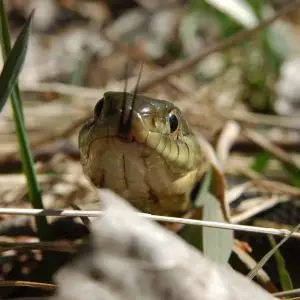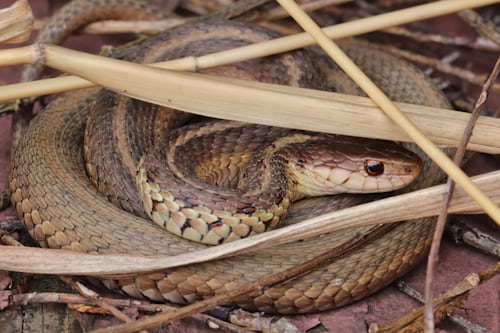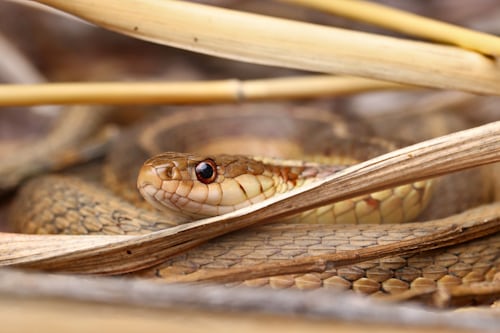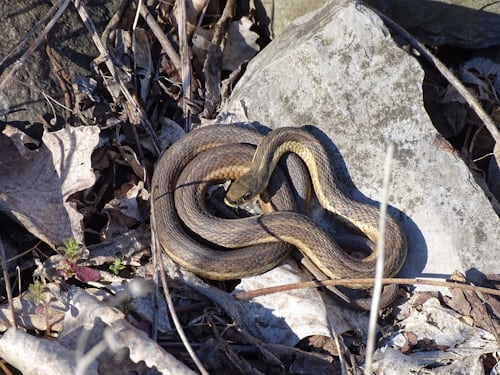
Garter Snake
Garter Snake
The garter snake is a common species of non-venomous snake that is found throughout North America. These snakes are typically small to medium in size, with adults ranging from 18 to 48 inches in length, depending on the species.
Garter snakes are known for their distinct appearance, which typically includes a greenish-brown or olive-colored body with three yellowish stripes running the length of their bodies. These stripes are most prominent on the sides of the snake and may be broken or incomplete in some individuals.
These snakes are found in a wide range of habitats, including grasslands, forests, and wetlands, and they are often found near bodies of water such as streams, ponds, and lakes. Garter snakes are active during the day and are often seen basking in the sun or foraging for prey, which includes small animals such as insects, frogs, and rodents.
Garter snakes are harmless to humans and are actually beneficial to have around, as they help control the populations of pests and other small animals. If you encounter a garter snake, it is best to leave it alone and let it go about its business.
Here is the Classification of Garter Snakes:
Kingdom: Animalia
Phylum: Chordata
Class: Reptilia
Order: Squamata
Suborder: Serpentes
Family: Natricidae
Genus: Thamnophis
There are currently over 30 recognized species of garter snakes within the Thamnophis genus, and they are all members of the Natricidae family of snakes, which includes other aquatic and semi-aquatic snake species.
Here are some of the Characteristics of Garter snakes:
Appearance: Garter snakes have a slender body, with smooth scales that can range in color from greenish-brown to black, with a white, yellow or red stripe down the center of their back, and two smaller stripes along their sides.
Size: The size of garter snakes varies depending on the species, but on average, they range from 18 to 48 inches (45-122 cm) in length.
Habitat: Garter snakes are found throughout North America in a variety of habitats including grasslands, forests, and wetlands. They are often found near water sources, such as streams, ponds, and lakes.
Diet: Garter snakes are carnivorous and feed on a variety of prey including insects, earthworms, frogs, toads, and small mammals.
Garter snakes are important members of their ecosystems, playing a key role in controlling populations of small animals and serving as prey for larger predators.
Here are some of the most notable behaviors of Garter snakes:
Garter snakes are known for their unique behaviors, which are influenced by factors such as their environment, diet, and social interactions.
1. Basking: Garter snakes are ectothermic, meaning that they rely on external sources of heat to regulate their body temperature. As a result, they often bask in the sun to warm up their bodies and increase their metabolism.
2. Foraging: Garter snakes are carnivorous and feed on a variety of prey, including insects, amphibians, and small mammals. They are active hunters and will use their sense of smell and sight to locate and capture their prey.
3. Hibernation: Garter snakes are cold-blooded and cannot tolerate extreme temperatures. During the winter, they will hibernate in underground dens or crevices to conserve energy and avoid freezing temperatures.
4.Social behavior: Garter snakes are known to exhibit a range of social behaviors, including courtship displays and communal hibernation. Some species are also known to form aggregations during the summer months, which can provide protection from predators.
5. Defensive behavior: When threatened, garter snakes may exhibit defensive behavior such as hissing, vibrating their tails, and releasing a foul-smelling musk from their cloaca.
the behavior of garter snakes is highly adaptable and can vary depending on their environment and the specific species. They are an important part of many ecosystems and play a key role in controlling populations of small animals.
Here are some of the common prey items that Garter snakes feed on:
1. Insects: Garter snakes feed on a variety of insects, including grasshoppers, crickets, and beetles.
2. Amphibians: Frogs and toads are a common prey item for garter snakes, especially in wetland habitats.
3. Fish: Some species of Garter snakes are semi-aquatic and will feed on fish, especially small minnows and other small fish species.
4. Small mammals: Garter snakes will also feed on small mammals such as mice and voles.
5. Earthworms: Garter snakes are also known to feed on earthworms, which can provide a high source of protein.
Here are some of the common habitats where Garter snakes can be found:
Garter snakes are found throughout North America, from Canada to Central America, and are adapted to a variety of habitats.
1. Grasslands: Garter snakes are well adapted to grassland habitats, where they can find a variety of prey items such as insects, rodents, and other small animals.
2. Forests: Many species of Garter snakes can be found in forested habitats, where they are often found near streams and other water sources.
3. Wetlands: Garter snakes are also found in wetland habitats such as marshes, swamps, and bogs, where they feed on amphibians and other aquatic animals.
4. Urban areas: Some species of Garter snakes have adapted to living in urban areas and can be found in parks, gardens, and other green spaces.
5. Mountains: Garter snakes can also be found in mountainous regions, where they are adapted to cooler temperatures and can be found basking on rocks and other sunny areas.
Garter snakes are adaptable and can be found in a variety of habitats, as long as there is a source of food, shelter, and water. They are important members of many ecosystems and play a key role in controlling populations of small animals.
How Venomous is the Garter Snake?
Garter snakes are not considered venomous to humans. While they do produce a mild venom in their saliva, it is not toxic enough to harm humans. In fact, Garter snakes are generally considered harmless and are not known to bite humans unless they feel threatened or cornered.
When Garter snakes do bite, they usually only release a small amount of saliva, which can cause minor irritation and swelling at the site of the bite. In rare cases, individuals may have an allergic reaction to the saliva, but this is uncommon.
It is important to note that there are some species of snakes that closely resemble Garter snakes, such as the Eastern Coral Snake, which are venomous and potentially dangerous. It is therefore important to always exercise caution and avoid handling snakes unless you are trained and experienced in doing so.
Population and Conservation Status Garter snake
Common Garter Snake (Thamnophis sirtalis): This species is one of the most widespread and common Garter snakes in North America, and is not considered endangered.
San Francisco Garter Snake (Thamnophis sirtalis tetrataenia): This subspecies of the Common Garter Snake is considered endangered, with only a few hundred individuals remaining in the wild.
Eastern Massasauga Rattlesnake (Sistrurus catenatus): Although not technically a Garter snake, this species is closely related and is also found in North America. It is considered threatened or endangered in many states due to habitat loss and fragmentation.
The conservation status of Garter snakes is highly variable depending on the species and their habitat. Some species are relatively common and not of concern, while others are threatened or endangered due to habitat loss, fragmentation, and other threats. It is important to protect the habitats of these snakes and to reduce threats such as habitat loss, pollution, and climate change in order to ensure their survival.
Are Garter Snake Aggressive?
Garter snakes are generally not aggressive towards humans or other animals. They are usually docile and prefer to avoid confrontations. If they feel threatened, their first line of defense is to try to flee or hide. If they are cornered or cannot escape, they may defend themselves by hissing, puffing up, or even striking with a closed mouth.
In general, Garter snakes are not known to attack humans, but they may bite if they feel threatened or are handled improperly. It is important to handle snakes with care and to avoid handling them if you are not experienced or trained to do so. It is also important to avoid cornering or harassing snakes in their natural habitat.
While Garter snakes may defend themselves if they feel threatened, they are not aggressive towards humans or other animals and will usually try to avoid confrontation if possible.
What happens if you’re bitten by a Garter Snake?
If you are bitten by a Garter snake, the bite is usually not harmful to humans. Gart
er snakes are not venomous to humans, and their bites are generally considered harmless. However, the bite may still cause some pain, swelling, and redness around the bite site.
If you are bitten by a Garter snake, you should clean the bite area with soap and water and apply a clean bandage. You should also keep the affected limb elevated and seek medical attention if the symptoms worsen or do not improve within a few days. It is also important to monitor the bite for signs of infection, such as redness, warmth, and discharge.
While Garter snakes are not generally harmful to humans, it is important to remember that all wild animals can carry bacteria or other pathogens that can cause infections. If you are bitten by any animal, it is important to clean the wound thoroughly and seek medical attention if necessary.
Here are some fun facts about Garter Snake:
1. King cobras are the largest venomous snake in the world, growing up to 18 feet (5.5 meters) long.
2. They are also the only snakes that build nests for their eggs and guard them until they hatch.
3. King cobras are known for their distinctive hood, which they spread when they feel threatened or aggressive.
4. They are native to South and Southeast Asia and can be found in a variety of habitats, including forests, swamps, and agricultural areas.
5. King cobras are not only venomous, but also constrict their prey. They mainly feed on other snakes, but also eat lizards, birds, and small mammals.
6. They have a unique set of behaviors, such as the ability to stand up and look a human in the eye, and the tendency to sway back and forth when
threatened..
7. King cobras are important in traditional medicine and are used in some cultures to treat a variety of ailments, although there is little scientific evidence to support these claims.
8. While king cobras are dangerous and potentially deadly to humans, they are also threatened by habitat loss, hunting, and the pet trade.
9. Despite their fearsome reputation, king cobras are actually quite shy and will usually try to avoid confrontations with humans if possible.
10. They are a fascinating and important species, and efforts are being made to protect them and their habitats for future generations.

Blog Upload on - April 27, 2023
Views - 1178

posted By -
Animals Super Store
Related Posts
-
8 Things You Should Never Do To Your Dog
March 27, 2023 -
Manx Cat - Cat Without A Tail
March 4, 2023 -
Golden Flying Snake
April 29, 2023 -
Sheep Farming
May 9, 2022 -
 Black Mamba
Black Mamba
April 14, 2023 -
A to Z List of Bird Names With Picture
Sept. 14, 2023 -
Reticulated Python
April 13, 2023 -
 The role of goats in sustainable agriculture and land management
The role of goats in sustainable agriculture and land management
March 24, 2023





I see that your site is very informative, and every article is better than any other website's blog and articles. Your blog contains more information than any other. I think you are one of the best informative article writers, also I am sure you are. Somehow, I found another informative blog site that contains more information same as you. If you want more information about farming, then you can visit farmingplan.com sites. Farming Plan